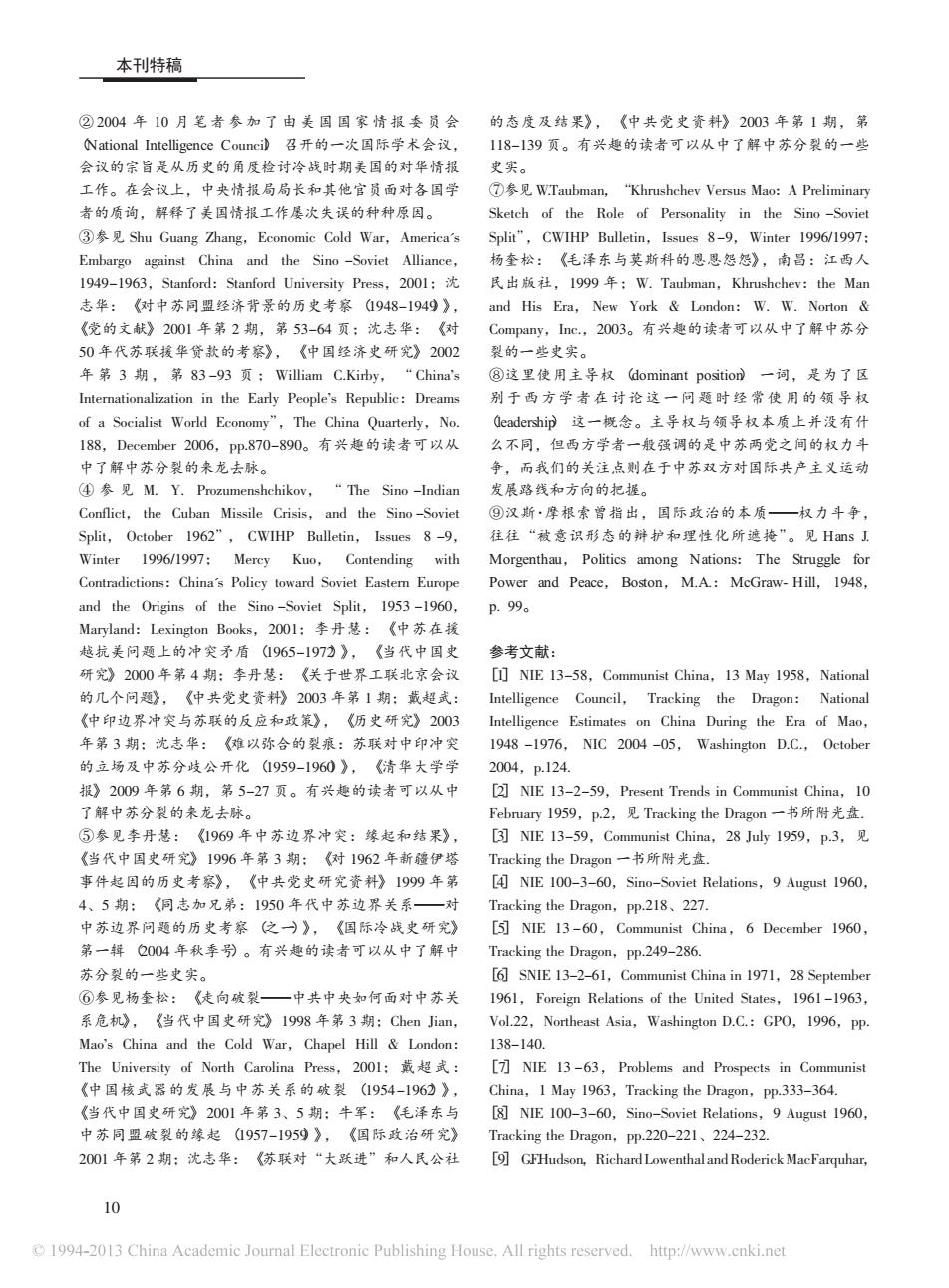正在加载图片...

本刊特稿 ②2004年10月笔者参加了由美国国家情报委员会 的态度及结果》,《中共党史资料》2003年第1期,第 National Intelligence Counci召开的一次国际学术会议, 118-139页。有兴趣的读者可以从中了解中苏分裂的一些 会议的宗旨是从历史的角度检讨冷战时期美国的对华情报 史实。 工作。在会议上,中央情报局局长和其他官员面对各国学 ⑦参见W.Taubman,“Khrushchev Versus Mao:A Preliminary 者的质询,解释了美国情报工作屡次失误的种种原因。 Sketch of the Role of Personality in the Sino -Soviet ③参见Shu Guang Zhang,Economic Cold War,America's Split",CWIHP Bulletin,Issues 8-9,Winter 1996/1997: Embargo against China and the Sino-Soviet Alliance, 杨奎松:《毛泽东与莫斯科的思思怨怨》,南昌:江西人 1949-1963,Stanford:Stanford University Press,2001: 民出版社,I999年:W.Taubman,Khrushchev:the Man 志华:《对中苏同盟经济背景的历史考察1948-1949》, and His Era,New York London:W.W.Norton 《党的文献》2001年第2期,第53-64页:沈志华:《对 Company,Inc.,2003。有兴趣的读者可以从中了解中苏分 50年代苏联援华贷款的考察》,《中国经济史研究》2002 裂的一些史实。 年第3期,第83-93页:William C.Kirby,“China's ⑧这里使用主导权(dominant position)一词,是为了区 Internationalization in the Early People's Republic:Dreams 别于西方学者在讨论这一问题时经常使用的领导权 of a Socialist World Economy",The China Quarterly,No. (eadership这一概念。主导权与领导权本质上并没有什 188,December2006,Pp.870-890。有兴趣的读者可以从 么不同,但西方学者一般强调的是中苏两党之间的权力斗 中了解中苏分裂的来龙去脉。 争,而我们的关注点则在于中苏双方对国际共产主义运动 ④参见M.Y.Prozumenshchikov,.“The Sino-Indian 发展路线和方向的把握。 Conflict,the Cuban Missile Crisis,and the Sino-Soviet ⑨汉斯·摩根索曾指出,国际政治的本质一权力斗争, Split,October 1962",CWIHP Bulletin,Issues 8-9, 往往“被意识形态的辩护和理性化所遮掩”。见Hams】 Winter 1996/1997:Mercy Kuo,Contending with Morgenthau,Politics among Nations:The Struggle for Contradictions:China's Policy toward Soviet Eastem Europe Power and Peace,Boston,M.A.:McGraw-Hill,1948, and the Origins of the Sino-Soviet Split,1953-1960, p.99。 Maryland::Lexington Books,200l;李丹慧:《中苏在援 越抗美问题上的冲突矛盾1965-1972》,《当代中国史 参考文献: 研究》2000年第4期:李丹慧:《关于世界工联北京会议 [1]NIE 13-58,Communist China,13 May 1958,National 的几个问题》,《中共党史资料》2003年第1期:戴超武: Intelligence Council,Tracking the Dragon:National 《中印边界冲突与苏联的反应和政策》,《历史研究》2003 Intelligence Estimates on China During the Era of Mao, 年第3期:沈志华:《难以弥合的裂痕:苏联对中印冲突 1948-1976,NIC 2004-05,Washington D.C.,October 的立场及中苏分歧公开化1959-1960》,《清华大学学 2004,p.124. 报》2009年第6期,第5-27页。有兴趣的读者可以从中 [2]NIE 13-2-59,Present Trends in Communist China,10 了解中苏分裂的来龙去脉。 February1959,p.2,见Tracking the Dragon一书所附光盘. ⑤参见李丹慈:《1969年中苏边界冲突:缘起和结果》, [3]NIE 13-59,Communist China,28 July 1959,p.3, 《当代中国史研究》1996年第3期:《对1962年新疆伊塔 Tracking the Dragon一书所附光盘. 事件起因的历史考察》,《中共党史研究资科》1999年第 [4]NIE 100-3-60,Sino-Soviet Relations,9 August 1960. 4、5期:《同志加兄弟:1950年代中苏边界关系一对 Tracking the Dragon,pp.218.227. 中苏边界问题的历史考察(之→》,《国际冷战史研究》 [5]NIE 13-60,Communist China,6 December 1960, 第一辑004年秋季别。有兴趣的读者可以从中了解中 Tracking the Dragon,pp.249-286. 苏分裂的一些史实。 [6]SNIE 13-2-61,Communist China in 1971,28 September ⑥参见杨奎松:《走向破裂一中共中央如何面对中苏关 1961,Foreign Relations of the United States,1961-1963, 系危机》,《当代中国史研究》1998年第3期:Chen Jian, Vol.22,Northeast Asia,Washington D.C.:GPO,1996,pp. Mao's China and the Cold War,Chapel Hill London: 138-140. The University of North Carolina Press,200l:戴超式:[刁NIEl3-63,Problems and Prospects in Communist 《中国核武器的发展与中苏关系的破裂(1954-196)》, China,I May 1963,Tracking the Dragon,pp.333-364. 《当代中国史研究》2001年第3、5期:牛军:《毛泽东与 [8]NIE 100-3-60,Sino-Soviet Relations,9 August 1960, 中苏同盟破裂的缘起1957-1959》,《国际政治研究》 Tracking the Dragon,pp.220-221 224-232. 2001年第2期:沈志华:《苏联对“大跃进”和人民公社 [GFHudson,Richard Lowenthal and Roderick MacFarquhar, 10 1994-2013 China Academic Journal Electronic Publishing House.All rights reserved.http://www.cnki.net② 2004 年 10 月 笔 者 参 加 了 由 美 国 国 家 情 报 委 员 会 (National Intelligence Council) 召开的一次国际学术会议, 会议的宗旨是从历史的角度检讨冷战时期美国的对华情报 工作。在会议上,中央情报局局长和其他官员面对各国学 者的质询,解释了美国情报工作屡次失误的种种原因。 ③参见 Shu Guang Zhang,Economic Cold War,America's Embargo against China and the Sino -Soviet Alliance, 1949-1963,Stanford:Stanford University Press,2001;沈 志华: 《对中苏同盟经济背景的历史考察 (1948-1949)》, 《党的文献》 2001 年第 2 期,第 53-64 页;沈志华: 《对 50 年代苏联援华贷款的考察》, 《中国经济史研究》 2002 年 第 3 期 , 第 83 -93 页 ; William C.Kirby, “ China's Internationalization in the Early People's Republic:Dreams of a Socialist World Economy”,The China Quarterly,No. 188,December 2006,pp.870-890。有兴趣的读者可以从 中了解中苏分裂的来龙去脉。 ④ 参 见 M. Y. Prozumenshchikov, “ The Sino -Indian Conflict, the Cuban Missile Crisis, and the Sino -Soviet Split, October 1962”, CWIHP Bulletin, Issues 8 -9, Winter 1996/1997; Mercy Kuo, Contending with Contradictions:China's Policy toward Soviet Eastern Europe and the Origins of the Sino -Soviet Split, 1953 -1960, Maryland:Lexington Books,2001;李丹慧: 《中苏在援 越抗美问题上的冲突矛盾 (1965-1972)》, 《当代中国史 研究》 2000 年第 4 期;李丹慧: 《关于世界工联北京会议 的几个问题》, 《中共党史资料》 2003 年第 1 期;戴超武: 《中印边界冲突与苏联的反应和政策》, 《历史研究》 2003 年第 3 期;沈志华: 《难以弥合的裂痕:苏联对中印冲突 的立场及中苏分歧公开化 (1959-1960)》, 《清华大学学 报》 2009 年第 6 期,第 5-27 页。有兴趣的读者可以从中 了解中苏分裂的来龙去脉。 ⑤参见李丹慧: 《1969 年中苏边界冲突:缘起和结果》, 《当代中国史研究》 1996 年第 3 期; 《对 1962 年新疆伊塔 事件起因的历史考察》, 《中共党史研究资料》 1999 年第 4、5 期; 《同志加兄弟:1950 年代中苏边界关系——对 中苏边界问题的历史考察 (之一)》, 《国际冷战史研究》 第一辑 (2004 年秋季号)。有兴趣的读者可以从中了解中 苏分裂的一些史实。 ⑥参见杨奎松: 《走向破裂——中共中央如何面对中苏关 系危机》, 《当代中国史研究》 1998 年第 3 期;Chen Jian, Mao's China and the Cold War,Chapel Hill & London: The University of North Carolina Press,2001; 戴 超 武 : 《中国核武器的发展与中苏关系的破裂 (1954-1962)》, 《当代中国史研究》 2001 年第 3、5 期;牛军: 《毛泽东与 中苏同盟破裂的缘起 (1957-1959)》, 《国际政治研究》 2001 年第 2 期;沈志华: 《苏联对“大跃进”和人民公社 的态度及结果》, 《中共党史资料》 2003 年第 1 期,第 118-139 页。有兴趣的读者可以从中了解中苏分裂的一些 史实。 ⑦参见 W.Taubman,“Khrushchev Versus Mao:A Preliminary Sketch of the Role of Personality in the Sino -Soviet Split”,CWIHP Bulletin,Issues 8 -9,Winter 1996/1997; 杨奎松: 《毛泽东与莫斯科的恩恩怨怨》,南昌:江西人 民出版社,1999 年;W. Taubman,Khrushchev:the Man and His Era, New York & London: W. W. Norton & Company,Inc.,2003。有兴趣的读者可以从中了解中苏分 裂的一些史实。 ⑧这里使用主导权 (dominant position) 一词,是为了区 别 于 西 方 学 者 在 讨 论 这 一 问 题 时 经 常 使 用 的 领 导 权 (leadership) 这一概念。主导权与领导权本质上并没有什 么不同,但西方学者一般强调的是中苏两党之间的权力斗 争,而我们的关注点则在于中苏双方对国际共产主义运动 发展路线和方向的把握。 ⑨汉斯·摩根索曾指出,国际政治的本质——权力斗争, 往往“被意识形态的辩护和理性化所遮掩”。见 Hans J. Morgenthau, Politics among Nations: The Struggle for Power and Peace, Boston, M.A.: McGraw- Hill, 1948, p. 99。 参考文献: [1] NIE 13-58,Communist China,13 May 1958,National Intelligence Council, Tracking the Dragon: National Intelligence Estimates on China During the Era of Mao, 1948 -1976, NIC 2004 -05, Washington D.C., October 2004,p.124. [2] NIE 13-2-59,Present Trends in Communist China,10 February 1959,p.2,见 Tracking the Dragon 一书所附光盘. [3] NIE 13-59,Communist China,28 July 1959,p.3,见 Tracking the Dragon 一书所附光盘. [4] NIE 100-3-60,Sino-Soviet Relations,9 August 1960, Tracking the Dragon,pp.218、227. [5] NIE 13 -60, Communist China, 6 December 1960, Tracking the Dragon,pp.249-286. [6] SNIE 13-2-61,Communist China in 1971,28 September 1961,Foreign Relations of the United States,1961 -1963, Vol.22,Northeast Asia,Washington D.C.:GPO,1996,pp. 138-140. [7] NIE 13 -63, Problems and Prospects in Communist China,1 May 1963,Tracking the Dragon,pp.333-364. [8] NIE 100-3-60,Sino-Soviet Relations,9 August 1960, Tracking the Dragon,pp.220-221、224-232. [9] G.F.Hudson,Richard Lowenthal andRoderick MacFarquhar, 本刊特稿 10